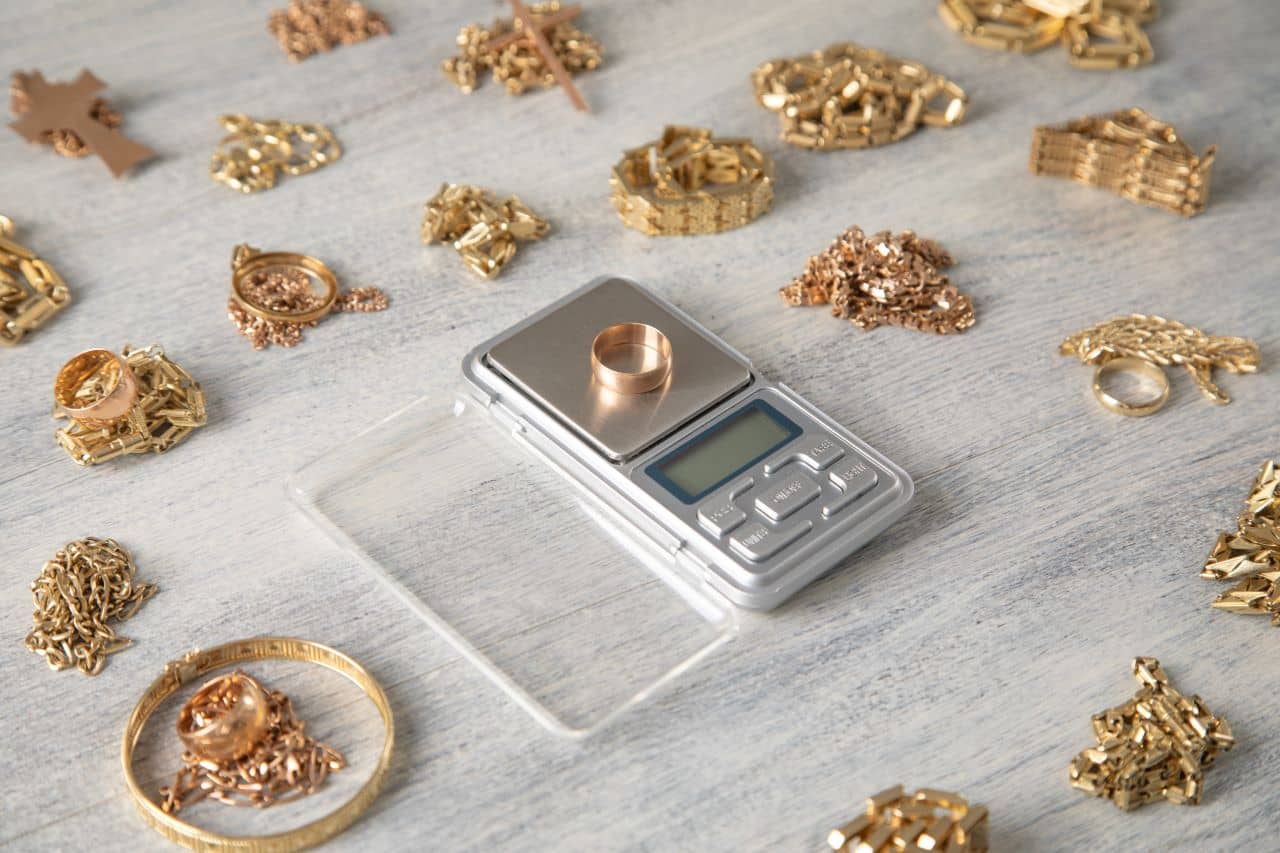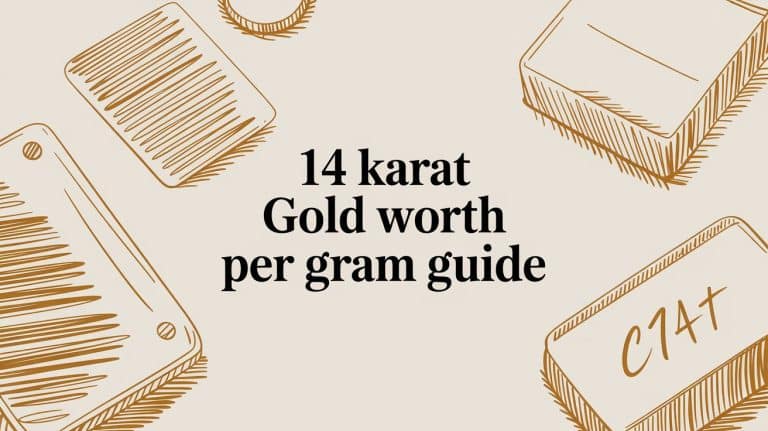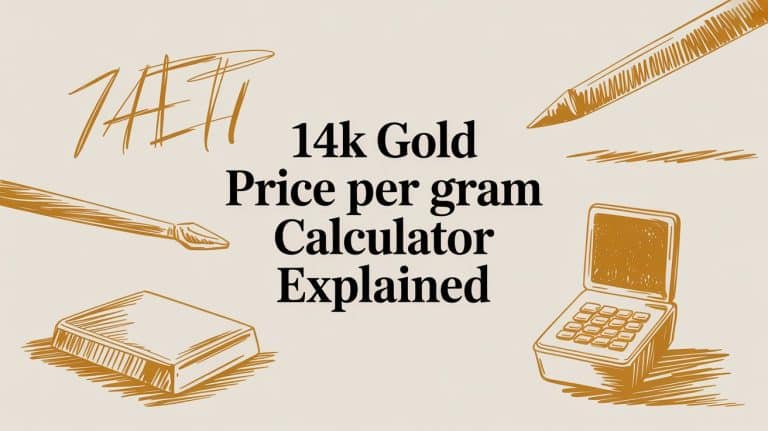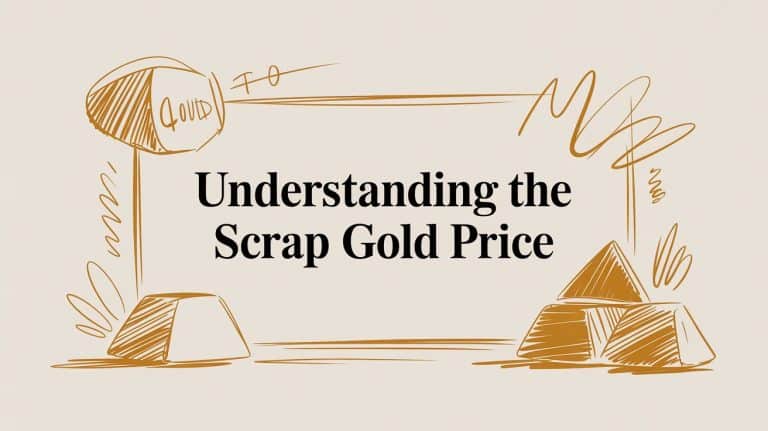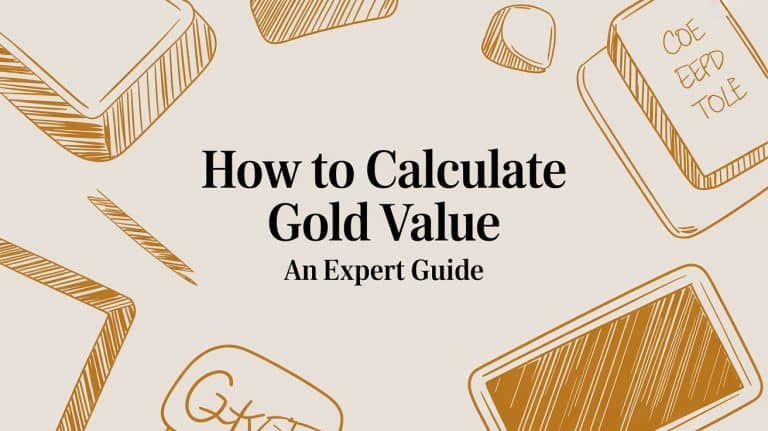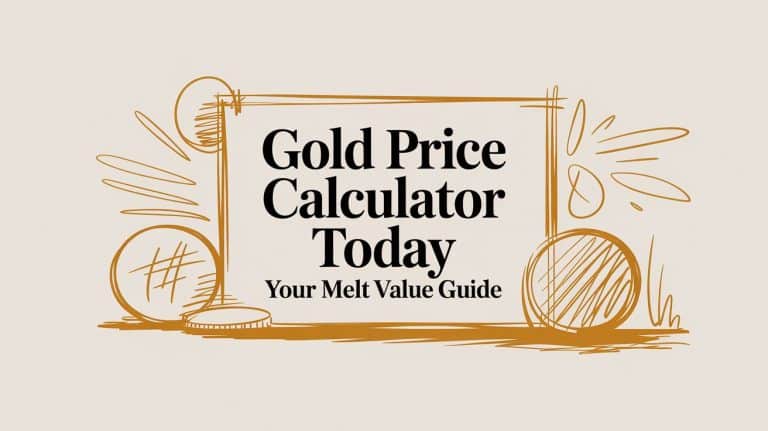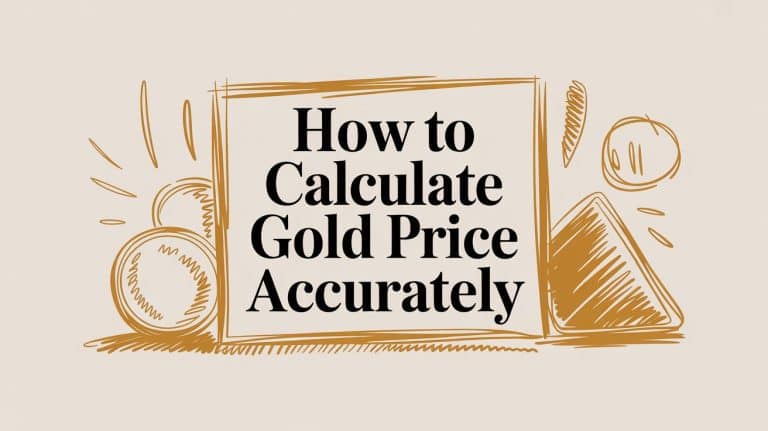How to Calculate the Scrap Value of a Gold Necklace: A Complete Guide
Have you ever wondered what that old gold necklace sitting in your jewelry box might actually be worth? Whether you’re cleaning out your collection, inherited some pieces, or simply curious about your jewelry’s value beyond its sentimental worth, understanding how to calculate the scrap value of a gold necklace can be incredibly useful knowledge.
If you’re new to this concept, don’t worry! Learning how to calculate the scrap value of a gold necklace is a straightforward process once you understand a few key factors. In this comprehensive guide, we’ll walk through everything you need to know, from basic formulas to insider tips that will help you get the most accurate valuation possible.
What Determines the Value of Scrap Gold?
Before diving into calculations, it’s important to understand what actually determines the value of your gold necklace when selling it as scrap:
- Weight: How heavy your necklace is (measured in grams or troy ounces)
- Purity: The karat rating that indicates gold content
- Current market price: The daily spot price of gold
- Buyer’s premium: The percentage a dealer will deduct from the theoretical value
Let’s explore each of these factors in detail so you can confidently assess what your jewelry is worth.
Calculate Gold Scrap Value: The Basic Formula
The fundamental formula for calculating scrap gold value is:
Scrap Value = (Weight in grams) × (Purity as a decimal) × (Current gold price per gram)This formula gives you the theoretical melt value of your gold—essentially what the raw gold in your necklace is worth based on current market prices. Let’s break down how to determine each component.
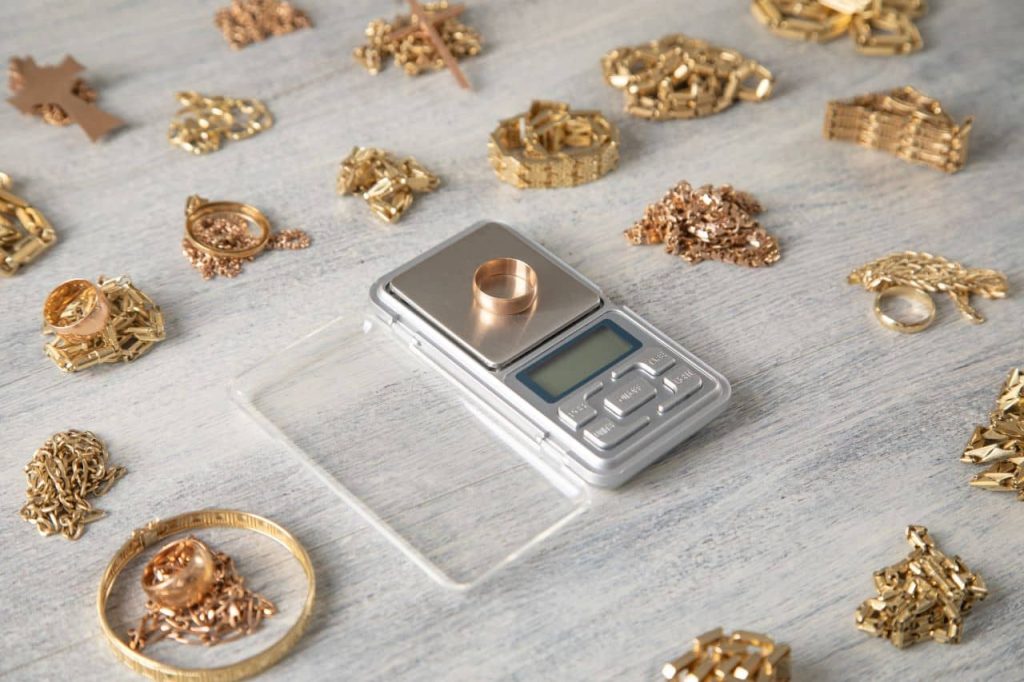
Step 1: Determine the Purity (Karat) of Your Gold
Gold jewelry is rarely made of pure gold. Instead, it contains varying amounts of other metals to improve durability and sometimes alter color. The karat marking tells you the purity:
| Karat | Gold Content (%) | Decimal Equivalent |
|---|---|---|
| 10K | 41.7% | 0.417 |
| 14K | 58.3% | 0.583 |
| 18K | 75.0% | 0.750 |
| 22K | 91.7% | 0.917 |
| 24K | 99.9% | 0.999 |
To find the purity of your necklace, look for small markings like “14K,” “18K,” etc. These are typically stamped somewhere on the clasp or chain. If you can’t find a marking, a jeweler can test it for you.
To use this in our formula, convert the karat to a decimal by dividing by 24. For example, 18K gold would be 18 ÷ 24 = 0.75 or 75% pure gold.
Step 2: Weigh Your Gold Necklace
For accurate calculations, you’ll need to know the weight of your necklace in grams. Digital kitchen scales can work in a pinch, but for more precision, consider these options:
- Use a jeweler’s digital scale (these measure down to 0.01 grams)
- Visit a local jeweler who can weigh it for you
- Purchase an inexpensive digital scale online that measures in grams
If you’re weighing at home, be sure to remove any non-gold components like gemstones or clasps made of other metals if possible.
Step 3: Find the Current Gold Price
Gold prices fluctuate daily based on global market conditions. To get an accurate calculation, you’ll need the most current price per gram. You can find this information:
- On financial websites like Kitco, APMEX, or JM Bullion
- Through gold price apps
- By checking the “spot price” quoted by gold dealers
Remember that the standard quoted price is for 24K (pure) gold. If you’re working with the price per troy ounce (a common quotation method), you’ll need to convert it to grams:
Price per gram = Price per troy ounce ÷ 31.1How to Calculate the Scrap Value of a 14K Gold Necklace at Home
Let’s walk through a practical example using a 14K gold necklace:
- Identify the purity: 14K = 14 ÷ 24 = 0.583 (58.3% pure gold)
- Weigh the necklace: Let’s say it weighs 25 grams
- Check today’s gold price: Assume the current price is $75 per gram for 24K gold
- Calculate the scrap value:
Scrap Value = 25g × 0.583 × $75 = $1,094.06
This gives you the theoretical melt value of your 14K gold necklace. However, it’s important to understand that dealers will typically pay less than this amount.
Realistic Expectations: The Buyer’s Premium
Gold buyers and refiners need to make a profit and cover processing costs. Therefore, they typically offer between 70% to 90% of the calculated melt value. Some factors that influence how much you’ll actually receive include:
- Current market conditions
- Competition among local buyers
- Quantity of gold you’re selling
- Processing and refining costs
- The buyer’s profit margin
For our 14K necklace example with a theoretical value of $1,094.06, here’s what you might realistically expect:
- High-end offer (90%): $984.65
- Mid-range offer (80%): $875.25
- Low-end offer (70%): $765.84
This is why it’s always worth shopping around for quotes from different buyers before selling.
Formula to Find Scrap Gold Value for Old Jewelry
When dealing with antique or vintage jewelry, there are additional considerations that might affect value. Sometimes older pieces contain higher purity gold than their markings suggest, while other pieces might have historical or artistic value beyond their metal content.
The Enhanced Formula for Vintage Pieces
For older jewelry, consider this expanded approach:
- Calculate the basic melt value using our standard formula
- Assess any premium for age or craftsmanship
- Evaluate any gemstones separately
- Consider the piece’s historical significance
If your necklace is particularly old or has unique craftsmanship, it might be worth getting an appraisal from an antique jewelry expert before selling it for scrap. You could be sitting on a collector’s item worth significantly more than its gold content!
Dealing with Mixed Metal Jewelry
Older necklaces sometimes contain mixed metals or have sections of different gold purities. In these cases:
- Separate components if possible
- Weigh each section individually
- Calculate the value of each component
- Add the values together
For example, a necklace might have an 18K pendant on a 14K chain. By calculating each separately, you’ll get a more accurate total value.
Best Way to Calculate Scrap Gold Value Without a Jeweler
While jewelers can provide professional assessments, you might want to calculate values yourself before approaching potential buyers. Here’s how to do it accurately:
DIY Testing Methods
For necklaces with unclear markings, you can try these at-home methods:
The Magnet Test: Gold is not magnetic. If your necklace sticks to a strong magnet, it’s likely gold-plated or made from another metal.
The Hallmark Check: Examine the clasp or chain for tiny markings indicating purity. Look for numbers like 585 (14K), 750 (18K), or 925 (sterling silver).
Color Assessment: Different gold alloys have distinct colors:
- Yellow gold is classic and most common
- White gold has a silvery appearance
- Rose gold has a pinkish hue
Online Gold Calculator for Quick Estimations
Try our free gold value calculator where you can input your necklace’s weight, purity, and get an instant value estimate based on current market prices. Some popular options include:
Digital Scale Recommendations
If you’re serious about calculating scrap values at home, investing in a good digital scale is worthwhile:
- Jewelry scales: These offer precision to 0.01g, perfect for lighter pieces
- Pocket scales: More affordable and still adequate for most jewelry
- Kitchen scales: Less precise but work in a pinch for heavier items
A quality jewelry scale typically costs between $20-50 and can be used for all your precious metal calculations.
Maximizing Your Gold Necklace’s Scrap Value
Want to get the highest possible price when selling your gold necklace? Consider these strategic approaches:
Timing the Market
Gold prices fluctuate daily based on economic conditions, geopolitical events, and investor sentiment. While it’s impossible to perfectly time the market, you can:
- Track gold prices over several weeks before selling
- Look for upward trends
- Avoid selling during significant dips
Many gold investors watch economic indicators like inflation rates, currency values, and stock market performance to predict gold price movements.
Preparation Before Selling
Properly preparing your necklace can help you get the best possible value:
- Clean your gold: Remove dirt and oils that might affect weighing accuracy
- Remove non-gold components: If possible, detach gemstones or non-gold parts
- Group by karat: If selling multiple pieces, separate them by purity
- Gather documentation: Any certificates or receipts from purchase
Negotiation Strategies
When approaching buyers:
- Get quotes from multiple sources (pawn shops, jewelers, online buyers)
- Show that you understand the current gold price and purity of your item
- Be willing to walk away from low offers
- Consider selling when you have a larger quantity to leverage better rates
Remember that competition among buyers can work in your favor. Some dealers may match or beat competitors’ offers if you mention other quotes you’ve received.
Understanding the Gold Market: Context for Your Calculations
Knowledge of the broader gold market can help you better interpret your calculations and make informed selling decisions:
What Drives Gold Prices?
Gold prices are influenced by several factors:
- Inflation: Gold is often seen as a hedge against inflation
- Currency strength: Particularly the US dollar
- Interest rates: Lower rates typically boost gold prices
- Geopolitical uncertainty: International conflicts often drive investors to gold
- Supply and demand: Mining output and central bank buying
By understanding these factors, you can better predict whether gold prices might rise or fall in the near term.
Seasonal Trends in Gold Buying
Interesting to note, there are seasonal patterns in gold prices:
- Wedding seasons: In countries with strong gold-buying traditions like India, prices often increase during wedding seasons
- Holiday periods: December often sees increased jewelry demand
- Quarter-end: Institutional investment rebalancing can affect prices
Some sellers time their sales to coincide with these traditional periods of higher demand.
Common Mistakes When Calculating Scrap Gold Value
Avoid these pitfalls that can lead to inaccurate estimates or disappointing returns:
Misidentifying Gold Purity
Perhaps the most common mistake is incorrectly identifying the purity of your gold. Gold-plated or gold-filled items contain minimal actual gold and are worth much less than solid gold pieces.
Signs your “gold” necklace might not be solid gold:
- Markings like “GP” (gold-plated), “GF” (gold-filled), or “HGE” (heavy gold electroplate)
- Discoloration or green/black tarnish
- Very lightweight despite substantial appearance
Calculation Errors
Double-check your math when performing calculations. Common errors include:
- Using the wrong conversion from karats to decimal purity
- Confusing grams with pennyweights or troy ounces
- Using outdated gold prices
- Applying the wrong formula
One decimal place error can significantly impact your expected value!
Unrealistic Expectations
Many first-time sellers expect to receive the full calculated melt value. Understanding that buyers need to make a profit will help set realistic expectations and prevent disappointment.
Ethical Considerations in Scrap Gold Sales
As consumers become more conscious about ethical sourcing, it’s worth considering the environmental and social impact of gold recycling:
The Environmental Impact of Gold Mining vs. Recycling
New gold mining can be environmentally destructive, requiring large amounts of energy and often using toxic chemicals. By selling your gold for recycling, you’re participating in a more sustainable gold cycle, as recycled gold requires no new mining.
Choosing Ethical Buyers
Some gold buyers emphasize ethical practices. Look for companies that:
- Support responsible sourcing initiatives
- Use environmentally friendly refining processes
- Offer fair prices to sellers
- Have transparent business practices
Making Informed Decisions About Your Gold Necklace
Understanding how to calculate the scrap value of a gold necklace empowers you to make informed decisions about your jewelry. Whether you’re decluttering, in need of cash, or simply curious about what your pieces are worth, the knowledge you’ve gained from this guide gives you a solid foundation.
Remember these key takeaways:
- The scrap value formula: Weight × Purity × Current Gold Price
- Actual payment will typically be 70-90% of the calculated melt value
- Vintage or artistic pieces might be worth more intact than as scrap
- Shopping around for quotes can significantly impact your return
By applying these principles, you can approach potential buyers with confidence, knowing exactly what your gold necklace is worth in today’s market. And perhaps most importantly, you’ll avoid selling valuable pieces for less than they’re truly worth.
Whether you decide to sell now, wait for better market conditions, or keep your necklace for sentimental reasons, you now have the tools to make that choice with complete information at your fingertips.


